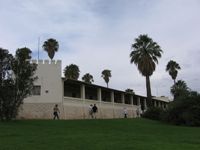
The Alte Fest, also known as the Schutztruppe Fort, served as the German colonial power's military headquarters until after World War One and today houses the state historical museum. German commander Curt von Francois laid the foundation stones in 1890, making it one of the oldest buildings in Windhoek and a significant national monument. In fact, the modern city more or less grew around the fort. Today, the museum's exhibition informs visitors of Namibia's history from its San origins to German occupation in 1884 and the resulting struggle for independence. The museum is a bit old-fashioned and rundown but still interesting. Emphasis is on the revolutionary struggle, with fascinating old photographs.
Address : Robert Mugabe Avenue
Telephone : Tel: (061) 293 4376
Opening times : Monday to Friday 9am-6pm, Saturday and Sunday 10am-12:00pm and 2pm-6pm (winter time closing time is 17.00).
Admission : Free
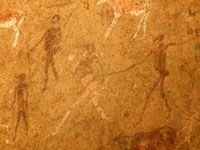
The Brandberg Massif is famous for its thousands of rock paintings and engravings. Its most celebrated piece is the 'White Lady', estimated to be around 2,000 years old. The painting shows a male with the white colour representing body paint which suggests it is a medicine man. Discovered in 1955, there has been a great deal of controversy over the meaning and origin of the painting. The mountain is a sacred place for the San tribes in the region. Brandberg's highest peak is Königstein, and at 8,550 feet (2,606m), it is the highest mountain in Namibia.
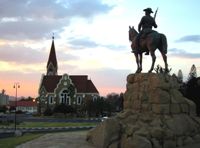
Christuskirche is a prominent landmark in the historic centre of Windhoek. A 79-foot (24m) spire tops the sandstone church, existing as a national monument. Its portal and altar are Italian marble, and its gothic revival face is unique by virtue of its Art Nouveau elements made from quartz sandstone. Interestingly, the stained glass windows, a gift from Emperor Wilhelm II, were installed backwards until the late 1990s when a tourist noticed the error. The church is a delight to explore, especially for those interested in architecture. The Parliamentary Gardens are wonderful for a stroll and a picnic, and are just around the corner form the church. There is also a small craft market nearby.
Address : Corner of Fidel Castro Str and Robert Mugabe Ave
Opening times : Monday to Friday 7:30am-2:30pm.
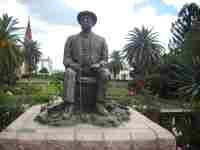
The National Botanic Garden of Namibia is a 12 hectare (30 acre) nature reserve in the heart of Windhoek, where tourists can hike, picnic, and learn about the country's fascinating plant life. The small nature reserve only opened to the public in the 1990s. The gardens are great for birdwatching, with lists of plants and birds found in the reserve available at reception. Guided tours are also in operation but should be booked in advance. The gardens can get very dry in winter, between June and September, and are at their most splendid when the plants are lush and in bloom during the rainy season, which is the best time to visit.
Website : www.nbri.org.na/?id=51
Opening times : Monday to Friday: 8am to 5pm. First Saturday of every month: 8am to 11am.
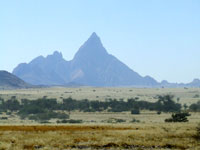
The natural beauty of the Spitzkoppe is spectacular: an island of bald granite peaks situated in an endless grassy plain that is visible for miles around. Groot Spitzkop is often referred to as the 'Matterhorn of Africa' because of its similarity in shape, and it is one of Namibia's most famous mountains. Nearby are the Little Spitzkoppe and the Pontok Mountains. Many San rock paintings exist in the Spitzkoppe area and these ancient artworks are thrilling to seek out. At the foot of Groot Spitzkop, Rhino Rock boasts some of the best surviving examples of prehistoric rock paintings. Sadly, many have been destroyed. The area is also renowned for its breath-taking sunrises, which turn the rocks from pale orange to flaming gold.
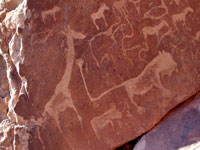
Twyfelfontein boasts the largest concentration of ancient rock art in the country, and is a UNESCO World Heritage Site. The petroglyphs primarily depict game animals such as giraffe, antelope, elephant, and lion, and the oldest carvings may date back 10,000 years. Most are believed to be around 3,000 years old. Translated as 'uncertain fountain', Twylfontein got its name from a farmer who doubted the spring's ability to sustain their cattle for a long period. Visitors can't enter the site without a guide due to previous vandalism. The uniquely-designed visitor information centre features an exhibition, kiosk, and souvenir shop. Other stunning sights in the area around Twyfelfontein include the Organ Pipes, the Doros Crater, and the Petrified Forest.

Travel Guide powered by Word Travels, copyright © 2023 Globe Media Ltd. By its very nature information in this travel guide is subject to change at short notice and travellers are urged to verify information on which they're relying with the relevant authorities. Neither Globe Media Ltd nor Travel Vogue can accept any responsibility for any loss or inconvenience to any person as a result of information contained above.